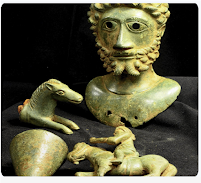Hanson's and their metal detectorist cataloguer went to town on this one. The text is more or less that which appeared in 'The searcher'magazine June 2021 issue pp.20-23, so there's a paper copy.
Lot 14:
The Ryedale Ritual Bronzes. A unique assemblage of Roman ritual artefacts from Yorkshire. My guess is that in metal detector school they do not have lessons in essay writing. Even in Cambridge First Certificate English (level B2), students are expected to be able to prepare a piece of written work in specific formats. One of them is "magazine article". What we see presented as a description of an assemblage of metal objects on sale by a "reputable" (?) English auction house falls far below that standard. Let us take Hanson's "Description" (1148 words) and extract the actual description of what is the object of the sale:
Consisting of a large bust, a horse and rider figurine, a zoomorphic knife handle and a pendulum [...]
Bust The 130mm high bronze bust, with its flamboyant hair and curly, forked beard appears to represent Marcus Aurelius[...] The bust is hollow, cast using the lost wax method and very finely modelled. Although the portrait is somewhat stylised, with large almond-shaped eyes [...] The back of the head has a hinged plate [dimensions?] which opens like a trap door to reveal the interior [dimensions?] [...] [Mars figure has weight given, this has not, shoddy and inconsistent]
Mars statuette. A cast bronze figurine of a rider on horseback, probably representing the God Mars [why?]. The horse and rider are well modelled, the horse harness with attached phalerae and reins clearly visible, though the latter are broken. Mars, wearing a helmet, short-sleeved tunic and pleated skirt, belted at the waist, sits astride the horse with his right arm raised to hold a spear. The left arm is held in front, bent at the elbow and the simple form of the forearm indicates it would have been held behind a shield, hidden from view. No traces of a shield were found in the hoard and it is possible that this was made from organic material. The horse has its right foreleg raised and the other legs have small pegs on the base of the hooves, indicating that the figurine would have been fixed into a plinth.[...] 86.8mm high. 222g.
Knife handle. A solid bronze knife handle in the form of a horse protome (the foreparts of a horse) [duh, but not just of horses, eh?]. The horse is well modelled with its front legs outstretched and head forward, as though leaping. [weightless?]
Pendulum/plumb bob. A large bronze conical plumb bob or pendulum measuring 72mm long, 40mm diameter and weighing 282g. The top is decorated with concentric circles and at the centre is a mushroom-shaped projection, which is pierced both vertically and horizontally for attachment to a line. [...]
That's it. The rest is narrativisation, based on the assumption that this was a single deposit and was ritual in function. The assumption continues: "
almost certainly represents a set of ritual equipment, buried as one deposit in the closing decades of the second century AD either at, or very close to, a rural temple or shrine site" Where is the evidence of that? What else has been found on this site to warrant such a leap in the dark? The same way is treated the details of discovery:
In May 2020 [so right in the middle of lockdown, eh? PMB], approximately 20 miles north of York, the Roman city of Eboracum, two friends Mark Didlick and James Spark unearthed an amazing assemblage of Roman bronze-work [...] almost certainly represents a set of ritual equipment, buried as one deposit [...]
The find was taken to York museum where it was recorded with the Portable Antiquities Scheme, reference number: YORYM-870B0E. Under current legislation this find did not fulfil the criteria to qualify as ‘Treasure’ so the hoard was returned to the finders [and landowner, eh? PMB].
And that's it. Now read how the PAS wrote it. No "trapdoor" and "flaming lamps to make the eyes come alive" [bust is too small to get one in, innit] No "Mars is on his horse", the knife handle is a key handle. Note how in the Hanson's account the utilitarian plumb bob has been turned into a New2 Agey "pendulum". The PAS account ends: "It may be possible to test these conjectures further if fuller context information becomes available". That's it "conjectures", additional to their description, not "almost certain" where interpretation is hopelessly muddled with description (a typical novice's mistake). And the context, as the PAS say is absolutely totally missing. Missing. The hoard, however, is from Ampleforth, not "Ryedale":
Hanson's to Sell Ampleforth Hoard PACHI 23rd April 2021; '
Value of a Discovery' PACHI 28th April 2021. Have the detecting pals stumbled on a real temple site there, with lots of coins and other treasures that they will now proceed to empty onto the market?
* Image © Hanson' Limited, fair use for purposes of comment or criticism for non-profit educational purposes.































